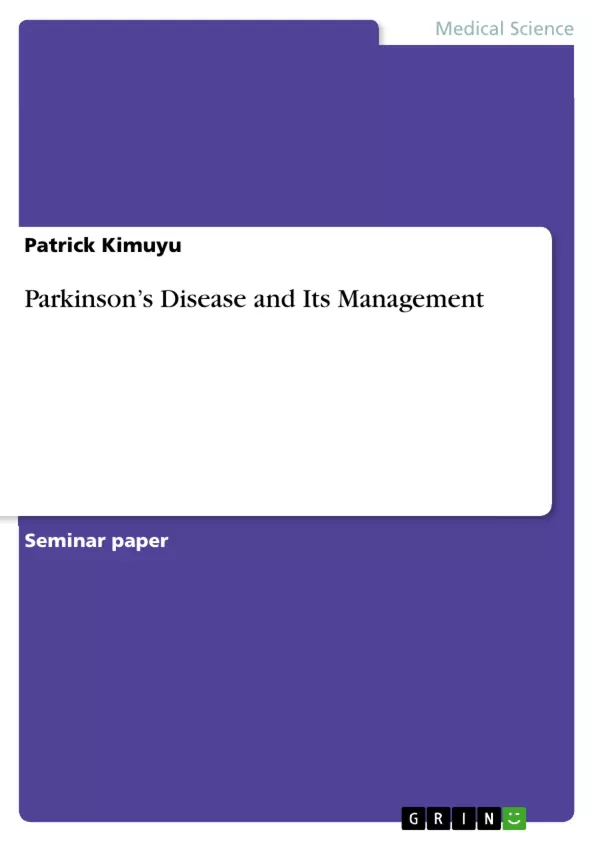This report provides an overview of Parkinson’s disease and its management.
Parkinson’s disease (PD) is considered as a progressive disorder of the central nervous system, and it is characterized by difficulties in movement. This disorder is also referred to as the shaking palsy owing to the tremors experienced by the patients. It is one of the most challenging motor system disorders because it is both chronic and progressive; implying that symptoms emerge and worsen over time. Therefore, the management of Parkinson’s disease presents an immense challenge to healthcare professionals, as well as families and relatives of patients suffering from the disease. Currently, there is no cure for Parkinson’s disease; thus, treatment approaches focus on reducing the severity of its symptoms.
Inhaltsverzeichnis (Table of Contents)
- Introduction
- Epidemiology
- Pathophysiology
- Signs and Symptoms
- Diagnosis
- Treatment
Zielsetzung und Themenschwerpunkte (Objectives and Key Themes)
This report provides a comprehensive overview of Parkinson's disease (PD), a progressive neurological disorder affecting movement. The text examines the uncertain etiology of PD, the disease's epidemiology, its pathophysiology, the signs and symptoms it presents, and current approaches to diagnosis and treatment. The report aims to educate readers about the complexities of this chronic condition.
- The complex and multifaceted nature of Parkinson's disease
- The role of environmental and genetic factors in the development of PD
- The impact of dopamine depletion on motor control and the manifestation of PD symptoms
- Challenges in diagnosing PD and the importance of multidisciplinary approaches
- The current state of treatment options for PD, including medication, surgery, and therapeutic interventions
Zusammenfassung der Kapitel (Chapter Summaries)
- Introduction: The chapter defines Parkinson's disease as a progressive disorder of the central nervous system characterized by movement difficulties. It emphasizes the chronic and progressive nature of the disease, highlighting the challenges it presents for healthcare professionals and families. The absence of a cure for PD leads to treatment approaches focused on symptom management. The chapter explores the uncertain etiology of PD, attributing it to a combination of environmental and genetic factors.
- Epidemiology: This chapter delves into the prevalence of Parkinson's disease, revealing its impact on individuals over 60 years old. The chapter provides global prevalence rates and highlights demographic trends, including a higher prevalence in men and variations across ethnicities. It provides statistics on the number of people suffering from PD in various countries.
- Pathophysiology: This chapter explores the complex biological mechanisms underlying Parkinson's disease. It examines the role of Lewy bodies and neurites in the disease progression, highlighting the absence of dopaminergic neurons in the brain. The chapter details how dopamine depletion affects the motor circuit and contributes to the development of PD symptoms.
- Signs and Symptoms: This chapter outlines the diverse array of signs and symptoms associated with Parkinson's disease. It describes the four cardinal signs—tremor, bradykinesia, rigidity, and postural instability—and discusses the progression of symptoms at various stages of the disease. The chapter also addresses the autonomic dysfunctions and non-motor symptoms that can occur in early stages of PD.
- Diagnosis: The chapter highlights the challenges in diagnosing Parkinson's disease, as there are no specific laboratory biomarkers. It explores various diagnostic approaches, including radiological studies, histological tests, and cerebrospinal fluid analysis. The chapter also discusses the role of homeopathy in managing the consequences of PD.
Schlüsselwörter (Keywords)
The key themes and concepts explored in this report include Parkinson's disease, motor system disorder, chronic illness, progressive disorder, etiology, environmental factors, genetic factors, epidemiology, pathophysiology, Lewy bodies, dopamine depletion, motor circuit, signs and symptoms, tremor, bradykinesia, rigidity, postural instability, diagnosis, treatment, medication, surgery, and neuroprotective therapies.
- Quote paper
- Patrick Kimuyu (Author), 2018, Parkinson’s Disease and Its Management, Munich, GRIN Verlag, https://www.grin.com/document/388411



